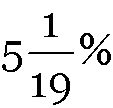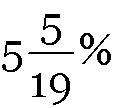Profit & Loss Worksheet-2
-
A man purchased sugar worth Rs. 400. He sold
 th at a loss of 10% and the remainder at a gain of 10%. On the whole, he gets:
th at a loss of 10% and the remainder at a gain of 10%. On the whole, he gets:
(a) a loss of 5% (b) a gain of 
(c) a loss of  (d) a loss of
(d) a loss of 
-
A businessman sold
 of his stock at a gain of 20% and the rest at a gain of 14%. The overall percentage of gain to the businessman is:
of his stock at a gain of 20% and the rest at a gain of 14%. The overall percentage of gain to the businessman is:
(a) 12% (b) 17% (c) 18% (d) 20%
-
A cloth merchant sold half of his cloth at 20% profit, half of the remaining at 20% loss and the rest was sold at the cost price. In the total transaction, his gain or loss will be:
(a) Neither loss nor gain (b) 5% loss
(c) 5% gain (d) 10% gain
-
A person purchases 90 clocks and sells 40 clocks at a gain of 10% and 50 clocks at a gain of 20%. If he sold all of them at a uniform profit of 15%, then he would have got Rs. 40 less. The cost price of each clock is:
(a) Rs. 50 (b) Rs. 60 (c) Rs. 80 (d) Rs. 90
-
A man bought goods worth Rs. 6000 and sold half of them at a gain of 10%. At what gain percent must he sell the remainder so as to get a gain of 25% on the whole?
(a) 25% (b) 30% (c) 35% (d) 40%
-
A fruitseller has 24 kg of apples. He sells a part of these at a gain of 20% and the balance at a loss of 5%. If on the whole he earns a profit of 10%, the amount of apples sold at a loss is:
(a) 4.6 kg (b) 6 kg (c) 9.6 kg (d) 11.4 kg
-
Two-third of a consignment was sold at a profit of 5% and the remainder at a loss of 2%. If the total profit was Rs. 400, the value of the consignment (in Rs.) was:
(a) 10,000 (b) 12,000 (c) 15,000 (d) 20,000
-
A trader purchases a watch and a wall clock for Rs. 390. He sells them making a profit of 10% on the watch and 15% on the wall clock. He earns a profit of Rs. 51.50. The difference between the original prices of the wall clock and the watch is equal to:
(a) Rs. 80 (b) Rs. 100 (c) Rs. 110 (d) Rs. 120
-
Albert buys 4 horses and 9 cows for Rs. 13,400. If he sells the horses at 10% profit and the cows at 20% profit, then he earns a total profit of Rs. 1880. The cost of a horse is:
(a) Rs. 1000 (b) Rs. 2000 (c) Rs. 2500 (d) Rs. 3000
-
A man purchases two clocks A and B at a total cost of Rs. 650. He sells A with 20% profit and B at a loss of 25% and gets the same selling price for both the clocks. What are the purchasing prices of A and B respectively?
(a) Rs. 225, Rs. 425 (b) Rs. 250, Rs. 400
(c) Rs. 275, Rs. 375 (d) Rs. 300, Rs. 350
-
The C.P. of two watches taken together is Rs. 840. If by selling one at a profit of 16% and the other at a loss of 12%, there is no loss or gain in the whole transaction, then the C.P. of the two watches are respectively:
(a) Rs. 360, Rs. 480 (b) Rs. 480, Rs. 360
(c) Rs. 380, Rs. 460 (d) Rs. 400, Rs. 440
-
On selling a chair at 7% loss and a table at 17% gain, a man gains Rs. 296. If he sells the chair at 7% gain and the table at 12% gain, then he gains Rs, 400. The actual price of the table is:
(a) Rs. 1600 (b) Rs. 1800 (c) Rs. 2200 (d) Rs. 2400
-
A shopkeeper offers 2.5% discount on cash purchases. What cash amount would Rohan pay for a cycle, the marked price of which is Rs. 650?
(a) Rs. 633.25 (b) Rs. 633.75 (c) Rs. 634 (d) Rs. 635
-
If a company sells a car with a marked price of Rs. 2,72,000 and gives a discount of 4% on Rs. 2,00,000 and 2.5% on the remaining amount of Rs. 72,000, then the actual price charged by the company for the car is:
(a) Rs. 2,50,000 (b) Rs. 2,55,000
(c) Rs. 2,60,100 (d) Rs. 2,62,200
-
Garima purchased a briefcase with an additional 10% discount on the reduced price after deducting 20% on the labelled price. If the labelled price was Rs. 1400, at what price did she purchase the briefcase?
(a) Rs. 980 (b) Rs. 1008 (c) Rs. 1056 (d) Rs. 1120
(e) None of these
Answer Key:
(1)-a; (2)-c; (3)-c; (4)-c; (5)-d; (6)-c; (7)-c; (8)-c; (9)-b; (10)-b; (11)-a; (12)-d; (13)-b; (14)-d; (15)-b
 th at a loss of 10% and the remainder at a gain of 10%. On the whole, he gets:
th at a loss of 10% and the remainder at a gain of 10%. On the whole, he gets:
 (d) a loss of
(d) a loss of 
 of his stock at a gain of 20% and the rest at a gain of 14%. The overall percentage of gain to the businessman is:
of his stock at a gain of 20% and the rest at a gain of 14%. The overall percentage of gain to the businessman is: